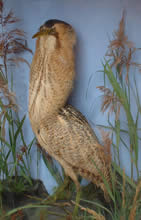| |
People
and climate have shaped Southwold’s diverse
habitats for birds, butterflies and sealife
– for better and worse. |
|
|
Once,
Southwold was home to a great variety of butterflies,
birds and sea creatures and the museum houses
collections of many specimens. But local wildlife
– as well as flowers, plants and trees
– have been under threat over the years
from lost habitat, climate change and sheer
human carelessness. |
|
|
|
| |
Death's
Head Hawk moth in the museum's collection.
Find out more. Click the photo.
|
|
|
|
|
|
How
are different species coping today? There’s
plenty of good news.
The once-common marbled white
and large tortoiseshell butterflies have vanished.
But the peacock, small tortoiseshell, white
admiral and red admiral and Green Hairstreak
(illustrated) are thriving locally. Buzzards
and sparrowhawks are now increasing as nests
are better protected and fewer birds poisoned.
Local reserve Hen
Reedbeds is a great success . Suffolk Wildlife
Trust has restored the area with interconnected
reedbeds, fens, dykes and pools to the delight
of bitterns, herons, otters, little egrets,
redshank and wildfowl. And in Reydon Wood, you
can see bluebells, orchids and other rare wild
flowers. |
|
|
|
|
|
|
|
|
|
|
|
|
|
| |
Left:
The ancient practice of coppicing
is continued in Reydon Wood. The
charateristic hornbeam stumps are
called 'coppice stools'. Click the
picture for more.
Right:
Green Hairstreak butterfly (Callophrys
rubi) found on boom and blackthorn
on local heathland.
|
|
|
| |
|
|
|
|
|
|
|
Reydon
Wood, between the villages of Reydon
and Wangford, is a typical Suffolk ancient
wood. The Wildlife Trust coppice the trees
regularly to allow the light to encourage
spring flowers.
Visitors enjoy the bluebell
carpet in spring, while the common spotted
orchid and early purple orchid are regularly
to be seen. Insects include the speckled
wood butterfly and gatekeeper butterfly
Other habitats to explore
are the heathlands
at Walberswick, Dunwich and nearby
Wenhaston Common, the salt
marshes, the grazing
marshes beside Southwold Common and,
of course, the coastal
margins. |
|
|
|
|
|
|
|
|
Boom,
Boom! |
|
|
|
|
|
 |
|
|
This
bittern is stuffed and has been on display in
the museum for decades. Until recently it was
just about the only bittern left in East Suffolk.
But now it has some real-life competition...
Just up the road at the Hen Reed Beds. Click
the picture to learn more.
|
|
|
|
|
|
|
|
|
|
|
|
|
 |
|
|
|
|
|
Stuffed
Heron in the museum's collection. Herons can
be seen in Southwold's
grazing marshes.
Click the picture for
more.
|
|
|
|
|
|
|